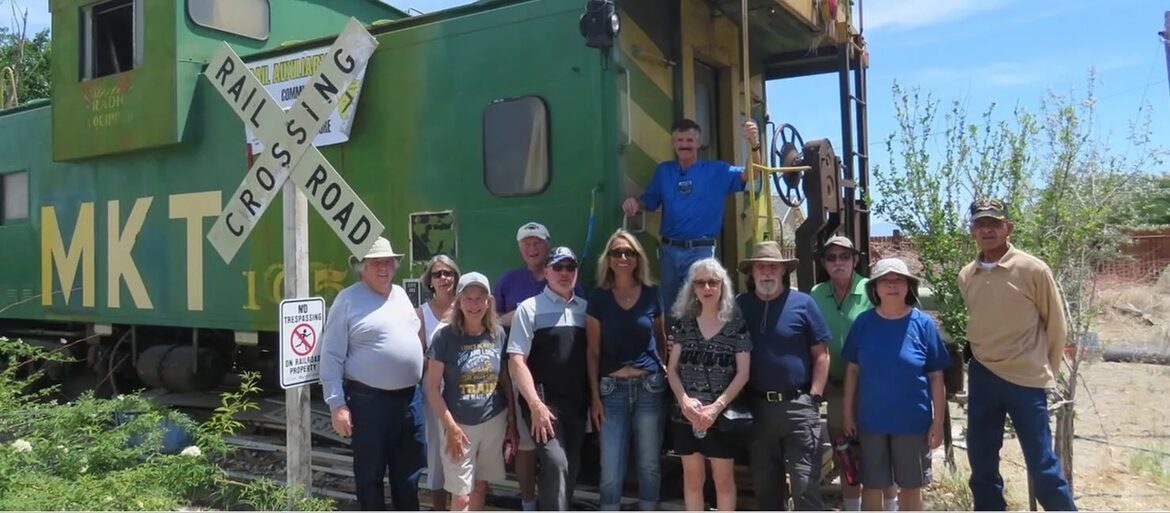Nevada veterans give back through Rail Auxiliary Team
Do you know what to do if you see someone walking on railroad tracks with a train barreling down in the distance? Or if your car gets stuck on the tracks?
The Rail Auxiliary Team in Washoe County, Nevada, educates the public on such topics and monitors local railroads to report people who might be in danger on or near train tracks. They also ensure railroad crossings are safe. Team members also are trained by the Nevada Office of Suicide Prevention to deal with potentially suicidal individuals.
The team, informally known as the “Rat Pack,” has more than 120 volunteers, mostly retired veterans, said Richard Gent, a retired naval officer from Fallon, Nevada, who created the team about eight years ago.![]()
In the United States, trains collide every three hours with either vehicles or pedestrians, Gent said.
“What we are trying to accomplish here is keep people safe and keep trained eyes near the railroad infrastructure,” he said. “Our guys and gals are out there looking at the railroad tracks, focusing on safety.”
Gent devised a curriculum of eight hours of classroom instruction for Rail Auxiliary Team volunteers. That includes basic railroading — such as how to identify different trains and box cars — reporting procedures, awareness of potential criminal activity and terrorist threats, and suicide awareness. Once part of the team, volunteers complete ongoing monthly classroom and online training, as well as field and tabletop exercise
Railroad tracks, and the land immediately adjacent to them, belong to railroad companies like Norfolk Southern Railway, BSN Santa Fe Railway, Amtrak and more. Rail Auxiliary Team volunteers wear orange reflective vests and are careful not to go onto railroad property, which constitutes trespassing, Gent said.
“The railroad has color codes for their personnel, and an orange vest signifies an individual on the ground,” he said. “A locomotive engineer will recognize it.”
Volunteers don’t operate in shifts, but rather check out railroads on their own time, whenever they are out and about, Gent said.
“What we say is, ‘Hey, if you’re going to Walmart, take a little side trip and go down by the railroad tracks and take a look,’” he said. “We found out it’s quite effective.”
Team members also use their own drones to survey railroad tracks from above, he said.
When team members spot something off, they alert the owners of the railroad, who in turn immediately contact train engineers, as well as law enforcement, for a quick response. The team calls in three to four reportable events per month, more in spring and summer, along the 50 or so miles of tracks in Washoe County, Gent said.
That has saved lives, such as last summer, when a team member reported a family walking along railroad tracks near the Cherokee River. The railroad company alerted the incoming train engineer who sounded the horn to prompt the family to get off the tracks, Gent said. Team members usually refrain from directly addressing trespassing individuals in order to avoid confrontations, he said.

Courtesy photo
Reporting malfunctions at railroad crossings, such as non-working lights, is another task the volunteers take on. In fact, anyone can do that by calling the toll-free phone number listed on blue emergency notification system signs placed at crossings, he said.
Additionally, the Rat Pack offers railroad education to the public, such as school bus drivers, emergency responders and others. Volunteer Art O’Connor, a veteran who lives in Reno, Nevada, said he especially enjoys giving lectures about railroad safety, such as what to do when a vehicle gets stuck on the tracks.
“(911 operators) have no clue how to stop that train, but if you call the 1-800 number on the emergency notification system sign, they will immediately stop the train and you will not become a statistic,” O’Connor said.
Volunteers also know about “hot spots,” such as railroad bridges that people like to cross on foot despite the danger of incoming trains, O’ Connor said. People should always use pedestrian bridges, no matter how inconvenient, he said.
O’Connor’s interest in railroads dates back to his youth, when he traveled by train from his family’s home in South Carolina to boarding school in Massachusetts. Volunteering with the Rail Auxiliary Team is all about giving back, he said.
“It’s rewarding,” he said.
Gent also has loved trains since childhood. He used to watch VHS tapes of moving trains while stationed in an aircraft carrier in the South China Sea, and now has a railroad caboose in his yard that he uses as an office, he said.
“It’s a strange disease,” he said, chuckling. “I’ve talked to other individuals that like trains, and it’s just a passion.”
When he approached the Washoe County Sheriff’s office eight years ago with his idea of creating the team, the reaction was immediately positive, Gent said. Now, he’d like to expand the Rail Auxiliary Team program throughout Nevada and across the country.
Joe Olaciregui, Citizen Corps Programs coordinator for the Washoe County Sheriff’s office, endorsed that.
“We are trying to grow the program so we can start getting it out to other counties and nationwide. It’s good for any place that has rail traffic that goes through it,” he said. “The bottom line is responder safety and life safety.”
Rail Auxiliary Team volunteers first go through the community emergency response team academy, of which they are an integral part, Olaciregui said. “That team is awesome,” he said. “They are absolutely killing it.”
For more information, visit the Washoe Sheriff’s Office website, Rail Auxiliary Team (RAT Pack) (washoesheriff.com)
